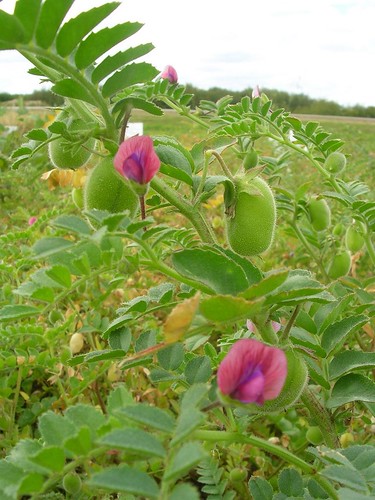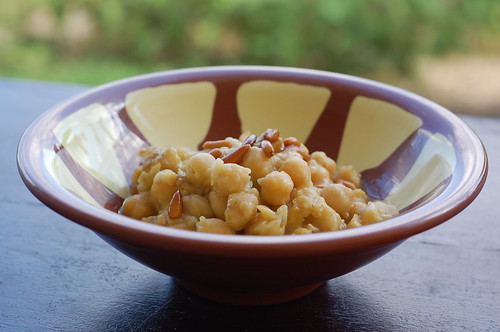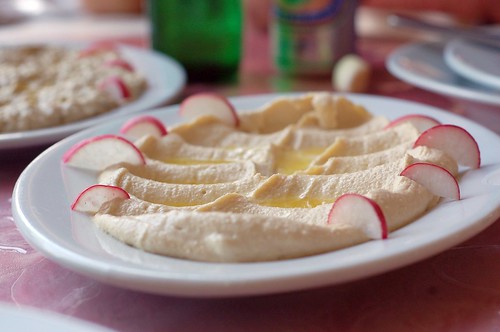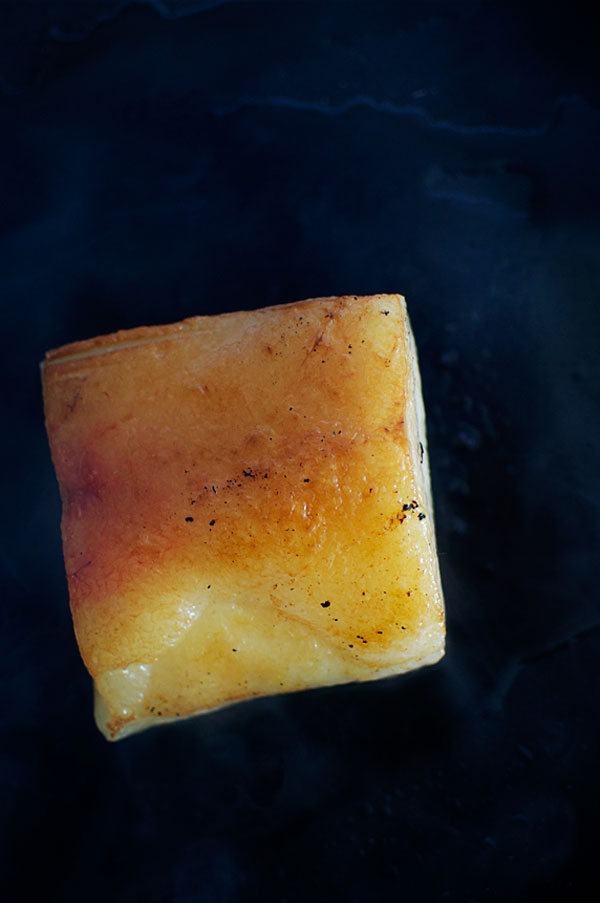
The chickpea plant, beautiful citrusy pods holding the bean
OK. So let’s set a few things straight here. Hommous (also spelled hummus or hommos) , is not a dish, and under no circumstance should it be an ingredient of a kebab. In fact, hommous is the Lebanese and Arabic word for chickpeas. The chickpea dip known the world over is what we the Lebanese call hommous b tahini. This name tells us that the chickpea dish is made with tahini. Chickpeas are eaten fresh (green) or dried (soaked and boiled). You can also buy the canned variety, but it is much cheaper and tastier if you soak and then boil them yourself. On its own, the chickpea is quite bland, but its merit comes from its ability to carry flavours and also from its texture. This texture works perfectly when blended with another Lebanese staple, tahini.

Baleelah: boiled chickpeas, aioli (yes we have that too), cumin and pine nuts, amazing!
Now tahini holds another point of contention. The product is the same whether it is spelled tahini or tahina. The word tahini itself denotes something that has been crushed, in this case, sesame seeds. The process is similar to making peanut butter, but the sesame seeds themselves are more oily and fragrant than peanuts, and crushing them results in a paste that is essential to the Lebanese cuisine, where it is used in more ways than you can imagine.

Fatteh: boiled chickpeas, garlic, yoghurt, olive oil, pine nuts on toasted Lebanese bread
But back to chickpeas, having just returned from Lebanon, I was reminded of the versatility of the hommous bean itself and the importance it holds in our cuisine. During the trip, I had more than 10 dishes where chickpeas were a central ingredient, and at least 4 where they were pretty much the only ingredient other than the sauce and spices used alongside. I remembered how we used to buy bunches of green (fresh) chickpeas and spend hours chatting, shelling and eating. Somewhat like peas, a good green chickpea should be had within hours of being picked, otherwise it gets chalky. Of all the great recipes for chickpeas, I thought you would most benefit from making the following dish.
Hommous b Tahini (Chickpeas in Tahini Sauce) Recipe
The most common chickpea dish known to man (Indian curries aside), hummous b tahini is often murdered at the hands of chefs and home cooks alike. It is at its finest when it is super smooth, perfectly balanced with tahini and lemon juice, and with just enough garlic. A Lebanese mother would never measure the ingredients and give out a recipe, as it is made with constant tasting of the ingredients to ensure the right balance is achieved. Here is an “algorithm” for making hommous b tahini, with tips to ensure the right consistency:
1- Soak chickpeas overnight with a spoon or two of sodium bicarbonate
2- Boil the hell out of the chickpeas. You want to be able to turn it into mush by simply pressing on the grain between your index and thumb
3- Drain but keep the cooking liquid as you will need it
4- Put in a food processor with no other liquid and blend.
5- If the food processor is not blending properly, add tiny amounts of cooking water, and I mean by the tablespoon just to get it going
6- Keep blending until very smooth. If you put too much liquid, it will not get smooth enough, and remain yucky and grainy
7- Add garlic, salt and lemon juice, blend again and adjust to taste.
8- Add tahini paste (a bit at a time), blend and taste.
9- Tahini will make the dip seize up, so add a bit of cooking liquid (or lemon juice if it needs it) to loosen it all up, but not too much. It should be be thick and creamy, not liquidy in any way. Have a look at how it holds its grooves in the picture above.
10- Adjust garlic, salt and lemon juice, plate up, make a sort of well in the middle and fill it with good olive oil! Huzzah!


25 comments
HI, I was just browsing your blog and very much enjoyed your stories and photos. Keep up the great work
Hi Camilla
Thanks for your encouragement. It's great to be complimented by a professional chef 🙂
Loving this blog for its interesting writing and its thoughtful photography!
SydneyCider, Have you ever grown your own chickpeas?
Thanks Lynne
I haven't grown my own chickpeas, but I've visited a farm that does grow them back in Lebanon. My recollection is not so good as I was 9 years old or so. But I grew up eating them fresh and they are great. Do you grow them?
Fouad
Excellent post on our Lebanese culinary treasure.
Hello fouad !
Your Hommus is the best ever ! (I’ve made it today) . Thanks for this post +your Tips.
greetings from Israel .
Chanit 🙂
I want to make hummos with meat but i don’t know how to call it; Kano in the Syrian Foodie says to call it hummos bel awarma even though it has no awarma; I say I need to call it bel-lahmeh, since it has lahmeh, what would you call it? Kano says all the restaurants in London (lebanese) call it bel-kawarma!
.-= tasteofbeirut´s last blog ..Spaghetti with fava bean and yogurt sauce =-.
Hi chanit – thanks. glad you enjoyed it
Hi Joumana – funny you mention it. I just had it tonight at a Lebanese restaurant in Sydney. They call it hommous b lahmeh. I’ve had it with awarma in lebanon of course, and that’s probably the traditional way of doing it. I’ve made it here with both minced meat and hand minced confit duck that was left over in my fridge. It’s great. You need plenty of pine nuts to go along with it.
Hi Fouad, Read about you in Chanit’s article. I LOVE Lebanese food so I visit my good friend Walid Talj owner of Dunyazad restaurant in Melbourne. But now I am going to check out your Hommous recipe as it tends to compete with my own! in my version I actually prepare the Tahini not using a raw one. Thank you again, Motti
Hi Motti
Thanks for your comment. I’ve never tried the food at Dunyazad. I’m pretty much a Sydney sider. I also share your opinion on your choice of tahini. A light one is certainly better visually and in flavour.
Stunning set of images.
to make a truly authenic hummos bi tahini you must peel the chickpeas prior to pureeing..this can be done by submerging them in water..rubbing the skins off /let them flott to the top and discard..repeat,,,sadly this tradion is disappearing as we are all in hurry,, but it makes for a creamier,intense and easier to digest hummos..once u eat it with peeled chikpeas it will be very had to eat them unpeeled..the same process should be used for falafel making
Hi Fouad!
Always enjoy visiting your blog, the photographs,writing style and recipes.
I hope you can help me. I am going to prepare hummous b tahini from 1kg of
dry hummous. Can you please, give me a rough guide to the amount of the other
ingredients needed.
thanks
Jac
Hi Jac
Uhm, Gee. Make sure you do it in batches because your food processor will break if you try to do all of them at once (lesson learned the hard way).
Here’s what I would think:
300 ml tahini
half a head of garlic
3 to 4 lemons
So, just make sure you have double that amount and you would be safe 🙂
Does that help?
Thanks
F
do any hommous dips have dairy in them ?
Hi Odin
Theoretically, no. Hummous is made with tahini and topped with olive oil, but if buying a packaged product, make sure you read the label.
Fouad
Hi Fouad
I have just stumbled on your blog. What a great read!
My parents migrated from Lebanon to Sydney in 1964, I arrived on the scene a year later so I have never been to the place of my heritage which greatly disappoints me. I would love to get there 1 day and presently planning a trip in July 2011.
I moved to Brisbane from Sydney in 1990 and have ever since craved traditional Lebanese food as there are very few Lebanese restaurants up here, as such, the existing ones tend to get away with murder in what they dish out.
I have quite a few Lebanese cookbooks which get me by and remind me of mum’s home cooking. This brings much joy not only to me but to my wife, my daughters and many friends!
Whenever we’re in Sydney, from the airport we make a B line to a particular Lebanese restaurant in Redfern and simply gorge ourselves akin to savages that have not eaten for days!
One area that has continually puzzled my is why restaurant Hommous b Tahini not only tastes fantastic but is very white in consistency yet, home made equivalent is tan in colour and tastes different. I have experimented with different chick peas and different tahini. I am now convinced there is another ingredient or process the professionals add that is not available in the traditional cookbooks.
My Australian wife now makes better hommous that I do!
I hope you can put me out this misery that I have carried for over 20 years!
Cheers
Richard
Hi Richard
Thanks for sharing your wonderful story with us. There are so many great cuisines in this world, but Lebanese remains my favourite.
Here are my tips for hummus
– Always soak in sodium bicarbonate
– boil the heck out of it
– as you blend it in the food processor, right at the end add an ice cube or two. It will turn white.
I hope that helps. Please do stay in touch 🙂
F
While not one of my favorite cuisines i can appreciate many of the Lebanese delicacies. Great photo’s too. Thanks for the write up.
This is one of my favorite foods of all time! For some reason, the day I thought to take a photo of it I left it a bit chunky, but I agree with you–it should be very smooth. I *especially* agree with your “just enough garlic.” I get so tired of everyone–home cooks and professionals alike–overdoing the garlic in absolutely everything they make!